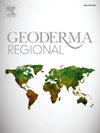Changes in soil organic carbon and phosphorus status under three different land use systems in a tropical Ultisol
IF 3.3
2区 农林科学
Q2 SOIL SCIENCE
引用次数: 0
Abstract
Anthropogenic land use systems and their management practices influence carbon (C) accumulation and storage and phosphorus (P) dynamics in soils. However, information on changes in soil organic C (SOC) reserves and P status in intensive annual cropping versus commercial perennial cropping systems is limited. This study examined the impact of long-term annual (vegetable) and perennial (tea) cultivation on the soil P and SOC status of a Tropical Ultisol compared to replanted forest land use. Surface (0–15 cm) soil samples obtained from forest- (25 ha), tea- (20 ha), and vegetable- (30 ha) lands within a micro-catchment were analyzed for available P (Mehlich 3-P), P fractions, SOC, permanganate oxidizable C (POxC, representing active SOC), and pH. Soils under long-term vegetable and tea with frequent applications of fertilizers had 78-fold and 7-fold greater available P (356.3 and 33.0 mg kg−1, respectively) than forest (4.6 mg kg−1) soils. Moreover, vegetable-grown soils had greater P concentrations in labile, moderately labile, and recalcitrant fractions than tea-grown and forest soils. Active C fraction in tea-grown soils (899 mg kg-1) was 2-fold than that of vegetable-grown soils (484 mg kg−1), but similar to forest soils (804 mg kg−1). The SOC in tea-grown and forest soils were similar (6.05 % and 5.84 %, respectively), but significantly higher than in vegetable-grown soil (4.50 %). Thus, soils from intensive annual cropping systems showed substantial P accumulations and lower SOC quantity and quality than perennial cropping systems, warranting better nutrient and SOC management and soil conservation measures to prevent further soil deterioration with annual cropping.

三种土地利用方式下热带Ultisol土壤有机碳和磷的变化
人为土地利用系统及其管理实践影响土壤中碳(C)的积累和储存以及磷(P)的动态。然而,关于一年生集约种植与商业多年生种植制度下土壤有机碳储量和磷含量变化的信息有限。本研究比较了长期一年生(蔬菜)和多年生(茶叶)种植对热带Ultisol土壤磷和有机碳状况的影响。在一个微集水区,从森林(25公顷)、茶叶(20公顷)和蔬菜(30公顷)土地上获得的表层(0-15厘米)土壤样本进行了有效磷(Mehlich 3-P)、磷组分、有机碳、高锰酸盐氧化C (POxC,代表活性有机碳)和ph的分析。长期施用蔬菜和茶叶并经常施用肥料的土壤的有效磷(分别为356.3和33.0 mg kg - 1)比森林(4.6 mg kg - 1)土壤高78倍和7倍。此外,蔬菜种植的土壤在不稳定、中等不稳定和顽固组分中的磷浓度高于茶叶种植和森林土壤。茶树土壤的活性碳含量(899 mg kg-1)是蔬菜土壤(484 mg kg-1)的2倍,与森林土壤(804 mg kg-1)相近。茶树土壤和森林土壤的有机碳含量相似(分别为6.05%和5.84%),但显著高于蔬菜土壤(4.50%)。因此,集约一年生种植系统的土壤磷素积累量较大,有机碳数量和质量较多年生种植系统低,因此需要更好的养分和有机碳管理以及土壤保持措施,以防止土壤因一年生种植而进一步恶化。
本文章由计算机程序翻译,如有差异,请以英文原文为准。
求助全文
约1分钟内获得全文
求助全文
来源期刊

Geoderma Regional
Agricultural and Biological Sciences-Soil Science
CiteScore
6.10
自引率
7.30%
发文量
122
审稿时长
76 days
期刊介绍:
Global issues require studies and solutions on national and regional levels. Geoderma Regional focuses on studies that increase understanding and advance our scientific knowledge of soils in all regions of the world. The journal embraces every aspect of soil science and welcomes reviews of regional progress.
 求助内容:
求助内容: 应助结果提醒方式:
应助结果提醒方式:


